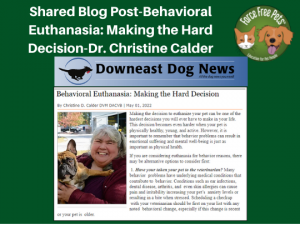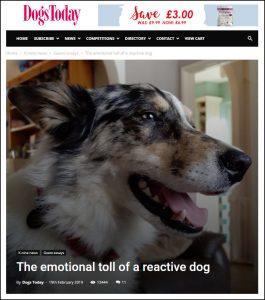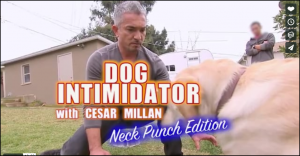< A version of this article was published in the May 2019 issue of Downeast Dog News>
A short link to this post – http://bit.ly/WWM-OpnLtrShltrs-MAY2019 >
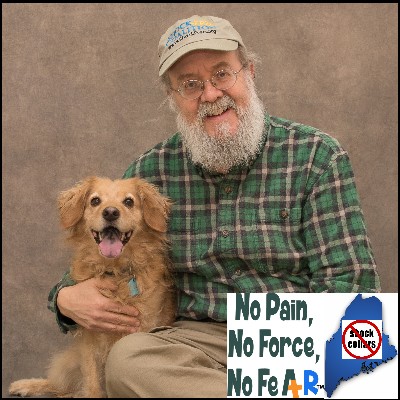 I unequivocally believe in the mission of animal rescue; it has provided me with seven dogs and six cats that became great companions.
I unequivocally believe in the mission of animal rescue; it has provided me with seven dogs and six cats that became great companions.
Having served on the board of a humane society for 15 years, I know that caring for and rehoming pets and funding those efforts is a challenging job.
I have worked with thousands of clients, and over half have had rescue pets. In most cases, they became treasured family members. However, I also know that despite an adopter’s best intentions and efforts a pet may not be an appropriate fit for their home and may even present a danger to people, others pets, or themselves. It is in the best interest of the animal, the adopter, and the rescuing organization that this happens as seldom as possible. Here are three steps that I believe are fundamental to making this happen.
Humane Treatment of The Pets Being Rescued
A shelter may place a pet with behavioral challenges because; 1) they never witnessed 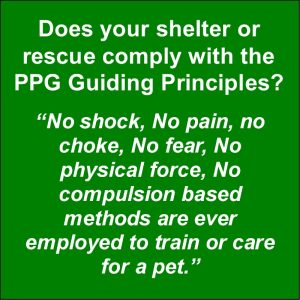 any problem behavior while the pet was in their care, 2) they lacked knowledge about behavior and were not experienced identifying behavior issues, or 3) they created aggression and fear with the use of aversive tools to “cure” these pets. Certified Animal Behavior Consultant (CABC) Steve Dale recently addressed this last issue in a blog post entitled
any problem behavior while the pet was in their care, 2) they lacked knowledge about behavior and were not experienced identifying behavior issues, or 3) they created aggression and fear with the use of aversive tools to “cure” these pets. Certified Animal Behavior Consultant (CABC) Steve Dale recently addressed this last issue in a blog post entitled  At What Cost Is Saving Dogs Acceptable1 ( FMI – http://bit.ly/2OvI0MY ). Dale asserts that some shelters have the attitude that their priority is to save every dog, no matter what, even if it involves using severe punishment such as shock collars. Dale believes that is unacceptable, and I concur, as does the Pet Professional Guild2 ( FMI–https://www.petprofessionalguild.com/shockcollars ) and the American Animal Hospital Association3 ( FMI–http://bit.ly/AAHA-2015BHx ).
At What Cost Is Saving Dogs Acceptable1 ( FMI – http://bit.ly/2OvI0MY ). Dale asserts that some shelters have the attitude that their priority is to save every dog, no matter what, even if it involves using severe punishment such as shock collars. Dale believes that is unacceptable, and I concur, as does the Pet Professional Guild2 ( FMI–https://www.petprofessionalguild.com/shockcollars ) and the American Animal Hospital Association3 ( FMI–http://bit.ly/AAHA-2015BHx ).
When I recommend a shelter or rescue, I expect three things:
- They are a member of the Pet Professional Guild. Membership in the PPG only costs a shelter or rescue $35/year. A small investment to demonstrate their commitment to “No, Pain, No Force, and No Fear,” and inconsequential considering the wealth of information available to them as part of their membership.
- They have policies in place, ensuring that they follow the PPG Guiding Principles and the AAHA Canine and Feline Behavior Management Guidelines.
- They have signed the Shock-Free Coalition Pledge.
Transparency About Behavioral Issues
In her blog post The Changing Role & Responsibility of Rescues & Shelters4 ( FMI–http://bit.ly/2HQHit9 ), Certified Professional Dog Trainer, Debbie Jacobs addresses the fact that many dogs end up in shelters with severe 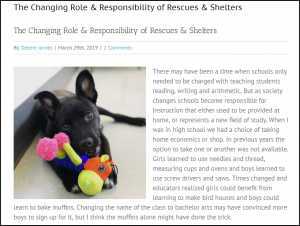 behavioral issues. She notes that in most cases shelters do not have the resources to successfully rehabilitate these dogs “efficiently and humanely” nor do most adopters. When most people adopt a pet they are not looking for a project in behavior modification; they merely want a companion.
behavioral issues. She notes that in most cases shelters do not have the resources to successfully rehabilitate these dogs “efficiently and humanely” nor do most adopters. When most people adopt a pet they are not looking for a project in behavior modification; they merely want a companion.
This week I had two different clients that adopted dogs from two different rescues. In the first case, the shelter minimized the potential difficulty of the adopter dealing with the dog’s separation anxiety. They got the dog home and quickly discovered she could not be left home alone without having an extreme panic attack, barking, defecating, and urinating throughout the house. This dog was suffering, and these people wanted to help, but they had to leave the dog alone part of the day because they had to work. Separation anxiety seldom resolves easily and rarely without professional help. That help and medication can be quite costly. The shelter should have recognized this home was not the right fit for this dog. Instead, their error further traumatized the dog and caused some severe emotional distress for the dog’s adopters who now felt as if they had failed. The only failure here was the shelter.
In the second case, my client adopted two dogs whom they were told were “strongly bonded” and had no issues. When they got the dogs home, the dogs were constantly fighting. The aggression was serious enough that my client’s veterinarian advised against keeping the dogs. The rescues owner said: “One of the dogs is a bit bossy, just let them work it out.” Aggression is a severe issue and does not fix itself. My clients made a difficult emotional decision to return these dogs. While they felt terrible, they knew they there were not equipped to deal with this level of inter-dog aggression. They wanted two dogs they could care for, not two dogs that wanted to hurt one another.
What MUST A Shelter/Rescue Do?
Be Humane! ALWAYS! – Develop policies and procedures that comply with the AAHA Canine  and Feline Behavior Management Guidelines ( http://bit.ly/AAHA-2015BHx ) and the PPG Guiding Principles ( http://bit.ly/PPG-GuidingPrinciples ) and then train your staff and volunteers and make sure that they are all following these policies. While you are at it, sign the Shock-Free Coalition Pledge ( https://www.shockfree.org/Pledge )
and Feline Behavior Management Guidelines ( http://bit.ly/AAHA-2015BHx ) and the PPG Guiding Principles ( http://bit.ly/PPG-GuidingPrinciples ) and then train your staff and volunteers and make sure that they are all following these policies. While you are at it, sign the Shock-Free Coalition Pledge ( https://www.shockfree.org/Pledge )
Be Honest and Transparent About Any Behavioral Issues – Behavioral issues such as separation anxiety, aggression, and resource guarding can present a danger to the animal, the adopter, and the public. If you have a pet in your shelter with these issues, you have a responsibility to be completely honest with all potential adopters. Always err on the side of public safety. If an adopter is at all hesitant, do NOT push the adoption so you can get one more pet out the door. I know many people who have had this experience and because of it will NEVER adopt from a rescue again.
Happily Accept All Returns with NO Shaming! – Not all placements are going to work. When someone brings a pet back, accept it cheerfully without trying to guilt or shame the adopter. Surrendering a pet was not an easy decision for them so please show them as much compassion as you would show the pet.
When advising clients on choosing a breeder most pet care professionals I know suggest one of the criteria of a good breeder is one that will take back any puppy they have sold, at any time, for any reason. Shelters and rescues need to step up and be held to the same standard.
Recommended References
1 At What Cost Is Savings Dog Acceptable – http://bit.ly/2OvI0MY
2 Pet Professional Guild (PPG) – Position Statement – The Use of Shock in Animal Training – https://www.petprofessionalguild.com/shockcollars
3 American Animal Hospital Association (AAHA) – 2015 AAHA Canine and Feline Behavior Management Guidelines – http://bit.ly/AAHA-2015BHx
4 The Changing Role & Responsibility of Rescues & Shelters – http://bit.ly/2HQHit9
Help! My Dog is Aggressive, Reactive, Fearful, Anxious, etc. – What do I do? – WWM – APR2017 – http://bit.ly/HelpDogAggx
The Unintended Consequences of Shock Collars – http://bit.ly/ShockCollars
Electric Shock Collars: Unreasonable Expectations and Misleading Advertising – WWM JUN2018 – http://bit.ly/ShockCollarExpectationsDeception
Things I Wish I Had Known Before I Started Training Dogs – Gus, the Dominance Myth, An Alpha Roll, and a Damaged Relationship – WWM-SEP2018 – http://bit.ly/Things-Gus-Dominance
Things I Wish I Had Known Before I Selected My First Dog – Aversives are Unnecessary and Counter-Productive When Training A Dog – Part 1 – WWM-JAN2019 – http://bit.ly/Things-Aversives-1
Things I Wish I Had Known Before I Selected My First Dog – Aversives are Unnecessary and Counter-Productive When Training A Dog – Part 2 – WWM-FEB2019 – http://bit.ly/Things-Aversives-2
Podcast – The Unintended Consequences of Shock Collars – http://bit.ly/ShockPodcast
Podcast – The Woof Meow Show: The Pet Professional Guild and the Shock-Free Coalition with Niki Tudge – http://bit.ly/PodCastShockFree-NikiTudge-2017
Web Sites
Pet Professional Guild – Join Today – https://www.petprofessionalguild.com/TheGuildApplicationForm
Pet Professional Guild – Find A Professional – http://bit.ly/PPG-Find-A-Prof
The Shock-Free Coalition – https://www.shockfree.org/
Take the Shock-Free Pledge – https://www.shockfree.org/Pledge
Shock-Free Pledge Signatures – https://www.shockfree.org/Signatures
Charity Navigator – https://www.charitynavigator.org
________________________________________________________________________
Don Hanson is the co-owner of the Green Acres Kennel Shop ( greenacreskennel.com ) in Bangor, ME where he has been helping people with their pets since 1995. He is a Bach Foundation Registered Animal Practitioner (BFRAP), Certified Dog Behavior Consultant (CDBC), Associate Certified Cat Behavior Consultant (ACCBC) and a Certified Professional Dog Trainer (CPDT-KA). Don is a member of the Pet Professional Guild (PPG) and is committed to PPG’s Guiding Principles and the Pain-Free, Force-Free, and Fear-Free training, management, and care of all pets. Don produces and co-hosts a weekly radio show and podcast, The Woof Meow Show, that airs on Z62 Retro Radio WZON (AM620) and WKIT 103.3-HD3 and is streamed at http://bit.ly/AM620-WZON every Saturday at 9 AM. Podcasts of the show are available at http://woofmeowshow.libsyn.com/, the Apple Podcast app, and at Don’s blog: www.words-woofs-meows.com. The opinions in this post are those of Don Hanson.
©2-May-19, Donald J. Hanson, All Rights Reserved
< Click for Copyright and Use Policy >
